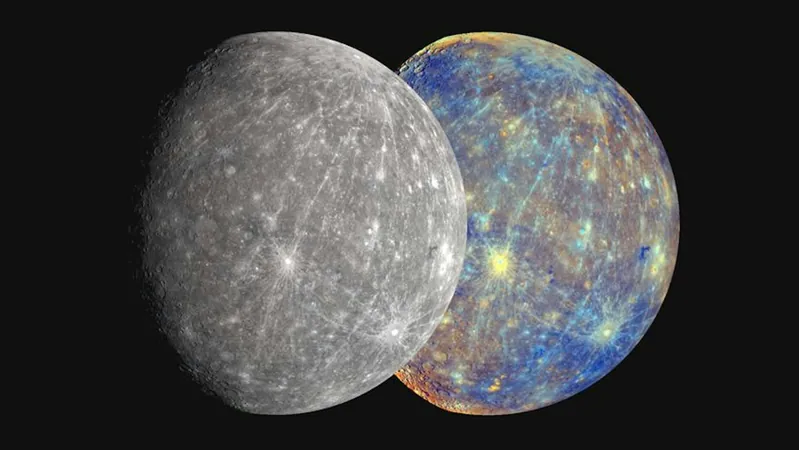
Breaking News: Scientists May Have Unearthed Meteorites from Mercury!
2025-07-03
Author: Olivia
A Cosmic Mystery Unraveled?
For years, scientists have pondered why, despite our frequent discovery of meteorites from the Moon and Mars, no fragments from Mercury—the solar system's innermost planet—have ever landed on Earth. Now, new research hints at a breakthrough that could shed light on this long-standing enigma.
Mercury’s Elusive Fragments
Most meteorites discovered on Earth originate from the asteroid belt, with a treasure trove of around 1,000 specimens from our Moon and Mars. Given Mercury’s proximity, one might expect similar finds from its surface. However, the absence of confirmed Mercurian meteorites has left scientists scratching their heads.
Two Meteorites That May Change Everything
In an exciting twist, a team of researchers has identified two meteorites—Ksar Ghilane 022 and Northwest Africa 15915—that could potentially hail from Mercury itself. If their claims are validated, these specimens might unlock secrets about Mercury's formation, revolutionizing our understanding of this enigmatic planet.
A Window into Mercury's Secrets
Due to its scorching proximity to the Sun, acquiring samples from Mercury through a space mission is both challenging and costly. Thus, the prospect of finding naturally occurring fragments becomes not just tantalizing, but vital for direct study.
What Makes These Meteorites Unique?
NASA’s Messenger mission has provided crucial insights into Mercury's composition, suggesting the presence of specific minerals like sodium-rich plagioclase and iron-poor pyroxenes. Initial candidates for Mercurian meteorites, including Northwest Africa 7325, faced scrutiny due to their mineral profiles not aligning with Mercury's expected makeup.
Aubrites: The Dark Horses
Aubrites, previously considered potential Mercurian fragments, didn’t quite match the chemical similarities with Mercury's surface, despite intriguing theories linking their origin to a planet of similar size.
The Evidence Grows Stronger
The latest investigation into Ksar Ghilane 022 and Northwest Africa 15915 reveals features such as olivine, pyroxene, and oldhamite, all of which align closely with what we would expect from Mercury’s crust. Their oxygen compositions match those of aubrites, adding weight to the hypothesis. Yet, discrepancies remain; both samples show minimal plagioclase compared to what is presumed to be found on Mercury's surface.
Can We Make the Connection?
Determining a meteorite's planetary origins is notoriously challenging. Past successes with lunar and Martian meteorites offer a glimpse into how these connections might be established, but until a mission samples Mercury directly, the true origins of these specimens will likely remain elusive.
What Comes Next?
The ongoing BepiColombo mission is poised to provide high-resolution images and data from Mercury, potentially leading us closer to understanding these meteorites’ origins. If these fragments are indeed from Mercury, they could answer critical questions about the planet's geological history and formation.
The Scientific Community Awaits Answers
As the debate continues, the scientific community eagerly anticipates discussions at the upcoming Meteoritical Society Meeting in Australia in 2025. The discovery of confirmed Mercurian meteorites could ignite a new era of exploration and understanding of our solar system. What secrets do these samples hold? Only time—and science—will tell!









 Brasil (PT)
Brasil (PT)
 Canada (EN)
Canada (EN)
 Chile (ES)
Chile (ES)
 Česko (CS)
Česko (CS)
 대한민국 (KO)
대한민국 (KO)
 España (ES)
España (ES)
 France (FR)
France (FR)
 Hong Kong (EN)
Hong Kong (EN)
 Italia (IT)
Italia (IT)
 日本 (JA)
日本 (JA)
 Magyarország (HU)
Magyarország (HU)
 Norge (NO)
Norge (NO)
 Polska (PL)
Polska (PL)
 Schweiz (DE)
Schweiz (DE)
 Singapore (EN)
Singapore (EN)
 Sverige (SV)
Sverige (SV)
 Suomi (FI)
Suomi (FI)
 Türkiye (TR)
Türkiye (TR)
 الإمارات العربية المتحدة (AR)
الإمارات العربية المتحدة (AR)